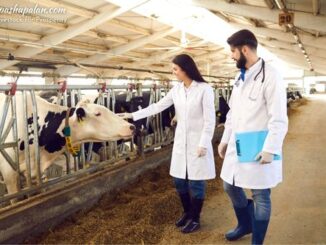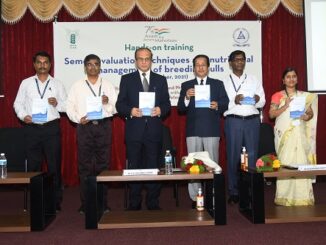Abstract
With increase in demand for food security and greater inclination towards protein diet livestock sector gaining importance. Farmers always have a wish for producing young ones of desired sex so as to maximize productivity and to secure sustainable livelihood. The demand for livestock products like meat, milk and dairy products have increased globally; to meet this demand, utilization of modern technologies to promote sustainable production of animals assumes paramount importance. Food and Agricultural Organization (FAO) of the United Nations estimated that the world’s food needs will increase by 100% in next 50 years and 70% of that increase will have to come from increased agricultural efficiencies and advances (Raymond et al., 2009).. Pre – sexed sperm or embryo mediated livestock production along with other genomic, proteomic and phenomics technologies offers a promising breeding strategy to meet the increased demand for food production (Rath et al., 2013). Determination of sex at the earliest stage can reduce the management cost thorough selective management of superior bulls or cows.Use of sexed semen fastens the genetic progress and allows the farm manger to increase selectively the number of heifers or steers based on the need of the farm. Moreover, predetermination of sex can reduce the management cost thorough selective management of superior bulls or cows. It also reduces calving difficulty (dystocia) in first calvers (Seidel, 2007) and reduces the replacement cost besides maintaining the biosecurity in farm. In mammals, sex determination is strictly chromosomal, and the sex of an offspring is entirely decided by the sperm. Male produces two types of sperm, half bearing the X-chromosome (X-sperm) and remaining half the Y-chromosome (Y-sperm) whereas the oocyte (ovum) produced by the females always carry an Xchromosome. Therefore, fertilization of an ovum by a Y-sperm produces a male (XY) and fertilization by an X-sperm produces a female (XX). Techniques for sexing of spermatozoa has been suitably modified and are being used commercially in several countries with about 90% accuracy in cattle. The available technologies have some impediment with respect to cost of production, implementation and pregnancy rate than control sperm. Development of techniques or instruments with high sorting rate and accuracy without damaging the spermatozoa would further hasten the progress of this technology.
Introduction
The underlying perspective for sex sorted semen:
- To enhance the income of farmers and also to substantially reduce ecological footprint.
- Allied sector coupled with advanced assisted reproductive techniques has potential to enhancing overall growth in agriculture.
- Ever increasing demand for milk and milk products.
(Annual report MAFW 2018-19 )
Artificial insemination of farm animals with sorted sperm is recognized by the FAO as a promising way of increasing efficiency of agriculture needed to produce enough food for the growing human population (Rathet al.,2013).
Basic Principles of Sex–Selection
Males produce two types of spermatozoa viz X or Y, when former bearing sperm fertilizes the egg it results in formation of female and when the egg is fertilized by the Y bearing sperm it results in male offspring. Thus a pragmatic approach to sex pre–selection could be to separate the sperm population containing the desired sex and to use in artificial insemination (AI) programs. This is possible only if we realize the differences between X and Y bearing spermatozoa. The major difference between the X and Y chromosomes, reported till date, is the DNA content; the amount of DNA in X chromosome carrying spermatozoa is higher than Y chromosome carrying spermatozoa. Other differences include the size of spermatozoa i.e. X sperm is larger than Y sperm
(Cui and Matthews, 1993; Cui, 1997; Moruzzi, 1979), motility (motility is reported to be higher in Y chromosome than X chromosome bearing spermatozoa) (Shettles, 1960), surface charges in sperm (X sperm has a negative charge and Y sperm has a positive charge) (Kiddy and Hafs, 1971) and cell surface antigens (Hoppe and Koo, 1984). Among these differential characteristics, differences in DNA content of spermatozoa have been shown to be the potential criteria for sorting of spermatozoa.
Commonly and prominently used methods
Flow Cytometry
Flow cytometers are the advanced cell sorters that use LASER to excite fluorescent dye that binds to the DNA in spermatozoa. The DNA percent and DNA specific dye are the major principle for sperm sexing through flow cytometry. In this method of sorting, the spermatozoa are treated with dye (e.g. Hoechst 33342), which is permeable to live and intact sperm membranes and binds to the DNA. Stained spermatozoa are transported to a point where they are exposed individually to a UV laser beam (wavelength of 351 – 364 nm) and the bright blue fluorescence emitted is detected and analyzed. Due to more DNA content in X chromosome bearing spermatozoa, it takes more stain than Y sperm. On the basis of this fluorescence, spermatozoa are classified as X or Y chromosome bearing and sorted. Another dye, commonly called “red quencher food colouring dye”, selectively penetrates into the damaged, dead and non – intact sperm membranes giving a red colour. Identification of live & dead sperm should be done before sorting process. Based on the excitation, spermatozoa are separated into discrete populations. In domestic animals the differences in DNA content between X and Y bearing spermatozoa ranges from 3 – 4.5% (Johnson et al., 1987; Johnson, 2000). Success rate in this method has been reported to be 85 – 95% (Pinkel et al., 1982; Johnson et al., 1989, 2000).
Among the various methods, flow cytometry based separation of sex specific spermatozoa is more popular and no other method has been consistently proven to be effective in producing offspring of the predicted sex till to date.
sorted rabbit sperm by Johnson et al (1989). Subsequently, hundreds of pre – sexed calves were born as a result of AI (Seidel, 2007). The first dairy calf from pre – determined sex after AI was reported by Seidel et al(1997) and first preselected calf was born through AI with frozen semen in 1999. The birth of the first calf after transfer of embryos produced following in – vitro fertilization with frozen thawed, sex sorted sperm was reported by Puglisi et al (2006).
Conception rate with sexed semen in heifers was about 70 – 80% and in lactating cows was about 50 – 60% (Seidel, 2003). In another study, it was reported that the conception rate in heifers was 45% and in lactating cows was 28% (De Vries et al., 2008). In contrast, conception rate of 69.7% with sexed sperm & 66.5% with unsexed sperm following AI was reported in China (Lu et al., 2010). In general, conception rate in lactating animals is low due to low insemination dose, large postpartum uterus and weak heat symptoms (Yoshida and Nakao, 2005). Therefore, higher number of inseminations and insemination doses are required for lactating cows to achieve more conception rate (Peppio et al., 2009).
Limitation of Sexed Semen Technology
Limitations can be due to different stages of processing level, staring from equipment, semen sorting procedure, post – sorting procedures, techniques of insemination and fertilizing ability of sexed semen.
- Cost of equipment and its patented technology are high.
- High cost for maintenance.
- Require skilled manpower for operation and supervision of machine.
- Slow process. i.e. less number of spermatozoa sorted per hour due to sexing of one sperm at a time rather than multiple sperm and thus less number of sperm are being identified for its sex or only less number of straws are being produced (7 – 10 dose/hour) (Seidel, 2007).
- Half of sperm sample are unsexable and go as waste (only 30% of sperm are sexable in which only 15% responsible for female offspring), leading to increased cost of sexed semen compared to unsexed semen ($35 – 65 vs $15 – 20).
- Efficiency of sexing of sperm is best with fresh sperm, so sorters should be located near the bull’s stations
- However, sorting pressure, speed, electrical deviation, laser radiation all leads to membrane alteration and pre-capacitation like changes in the sorted sperm leading to reduced fertility (Shiv Kumar Yadavet al.,2017)
- In pigs litter bearing- effects are more prominent as because in the conventional semen collection and artificial insemination methods the sperm concentration used in straw is usually very high but in sex sorted semen given the low sperm concentration conception rate will be hampered
- Several studies have found that the mRNA expression has been altered in sex sorted semen used individuals. (Morton et al.,2007)
- Preferential segregation of allele known as Meiotic drive and apoptosis could have negative repercussion on sex sorted semen (Sargustyet al.,2012)
- Efficiency of sexing of sperm is best with fresh sperm, so sorters should be located near the bull’s stations.
Current scenario in India
- THE HINDU Sept-04 (2019) report states that using sex-sorted semen- which increases the possibility of a female calf to about 90% also drastically increases the cost of insemination, as the technology is still new in India.
- The government-subsidized price of a single semen dose is only ₹20.
- Sex-sorted semen On the other hand, can cost ₹500 to 600 per dose.
- Of the 11.9 crore semen doses produced in the country every year, only 10 lakh are sex-sorted.
Future Perspective
Numerous methods have been reported to separate X- and Y-chromosome bearing sperm. However, the common underlying problem from these methods has been the lack of reproducibility. At present, FACS is the only proven effective method for sexing viable mammalian sperm. However, sexing of sperm by FACS technique still has problems in terms of high economic cost and sperm damage. Therefore, an economical, convenient, and non-invasive approach such as immunological methods for sperm sexing would be of benefit to agricultural sectors. In this regard, differentially expressed proteins present on the membrane of Xor Y-sperm may be promising for the development of new technology for semen sexing and identification of X- and Y-sperm.
The next frontier would be;
- Determination of sex at the earliest stage can reduce the management cost thorough selective management of superior bulls or cows.
- Use of sexed semen fastens the genetic progress and allows the farm manger to increase selectively the number of heifers or steers based on the need of the farm (Seidel et al.,2007)
- Separation of X- and Y-chromosome bearing sperm has been practiced for selection of desired sex of offspring to increase the profit in livestock industries (Shiv Kumar Yadavet al.,2017)
- Controlling the sex ratio entails direct returns in the livestock sector, allowing improved management of food production, animal welfare improvement, faster genetic selection, and a decrease of environmental impact (De Canio M et al.,2014)
- Recently Takashi Umeharaet al.2019 has conducted research and revealed the functional differences between Y-sperm and X-sperm motility and related to different gene expression patterns, specifically TLR7/8 on X-sperm. This could bolster the sperm sexing technology in the world.
Conclusion
- Success of sexed semen industry depends upon the sorting speed, accuracy and the fertility of sorted spermatozoa.
- The existing technologies, although used at commercial scales, are to be further refined for mass scale use of sexed semen.
- Identification of sperm surface markers specific for X or Y bearing spermatozoa and using them to sort spermatozoa is an option.
- Developing designer bulls that produce only one type (either X or Y) of spermatozoa by knocking out the other type is also possible, however it requires intensive research.
Whatever technologies we use, it all depend on the good management practices to achieve high conception or pregnancy rate with the predicted sex from the sorted sexed semen.






Be the first to comment